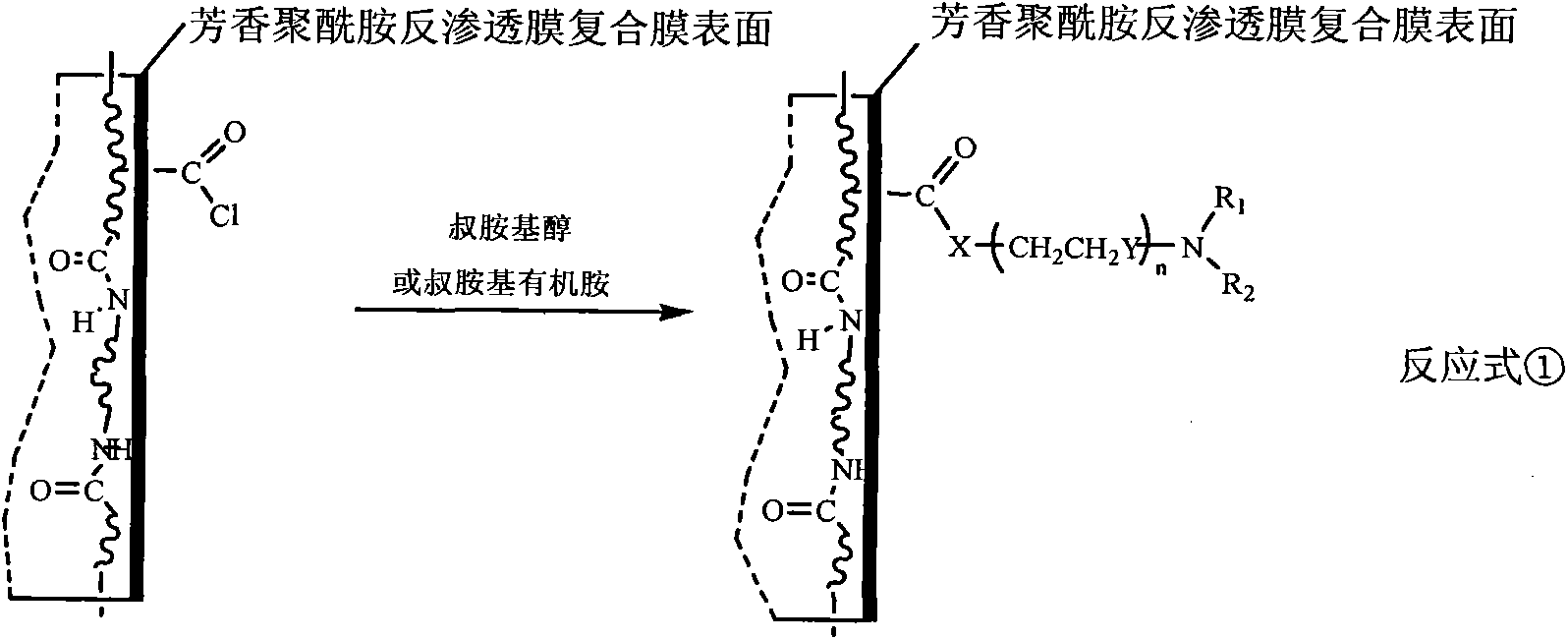Method of surface functionalization of aramatic polyamides reverse osmosis thin film composite membrane
A technology of reverse osmosis composite membrane and aromatic polyamide, which is applied to the surface modification of quaternary ammonium salt and salicylaldehyde functional group of aromatic polyamide reverse osmosis composite membrane, and the field of surface functionalization of aromatic polyamide reverse osmosis composite membrane, which can solve the problem. Problems such as poor modification uniformity, reduced permeability, and waste of monomer raw materials can achieve the effect of easy industrialization and simple method.
- Summary
- Abstract
- Description
- Claims
- Application Information
AI Technical Summary
Problems solved by technology
Method used
Image
Examples
Embodiment 1
[0046] Example 1 Preparation of aromatic polyamide-polysulfone composite membrane with quaternary ammonium salt and salicylaldehyde functional groups on the surface
[0047] Step 1: Preparation of aromatic polyamide-polysulfone composite membrane containing acid chloride groups on the surface
[0048] Take the purified and dried polysulfone support membrane with a molecular weight cut-off of 20,000 to 50,000 and immerse it in a methylene chloride solution with a concentration of 3 to 15% by mass percentage of m-phenylenediamine, immerse it at room temperature for 24 hours, take it out to air dry, and spray at room temperature A dichloromethane solution containing isophthaloyl chloride, trimesoyl chloride and triethylamine with a concentration of 3-15% by mass. After reacting at room temperature for 0.2 hours, increase the temperature to 50-90℃ and continue the reaction for 2 hours. , Wash with acetone, and dry in vacuum to obtain an aromatic polyamide-polysulfone composite membrane...
Embodiment 2
[0053] Example 2 Preparation of aromatic polyamide-polypropylene non-woven fabric composite membrane with quaternary ammonium salt and salicylaldehyde functional groups on the surface
[0054] In accordance with the method and operation steps of Example 1, the polysulfone support membrane in step 1 of Example 1 was replaced with polypropylene non-woven fabric to obtain an aromatic polyamide-polypropylene non-woven fabric with quaternary ammonium salt and salicylaldehyde on the surface. Woven composite membrane (referred to as QS-PEG-PA / PP composite membrane).
Embodiment 3
[0055] Example 3 Preparation of aromatic polyamide-cotton fiber filter paper composite membrane with quaternary ammonium salt and salicylaldehyde functional groups on the surface
[0056] According to the method and operation steps of Example 1, the polysulfone support membrane in step 1 of Example 1 was changed to cotton fiber filter paper, and the monodiethylamino polyethylene glycol in step 2 was changed to 2-(dimethylamino)ethyl Amine, that is, an aromatic polyamide-cotton fiber filter paper composite membrane (referred to as QS-DMA-PA / FP composite membrane) that is "planted" on the surface of quaternary ammonium salt and salicylaldehyde.
PUM
 Login to View More
Login to View More Abstract
Description
Claims
Application Information
 Login to View More
Login to View More - Generate Ideas
- Intellectual Property
- Life Sciences
- Materials
- Tech Scout
- Unparalleled Data Quality
- Higher Quality Content
- 60% Fewer Hallucinations
Browse by: Latest US Patents, China's latest patents, Technical Efficacy Thesaurus, Application Domain, Technology Topic, Popular Technical Reports.
© 2025 PatSnap. All rights reserved.Legal|Privacy policy|Modern Slavery Act Transparency Statement|Sitemap|About US| Contact US: help@patsnap.com



